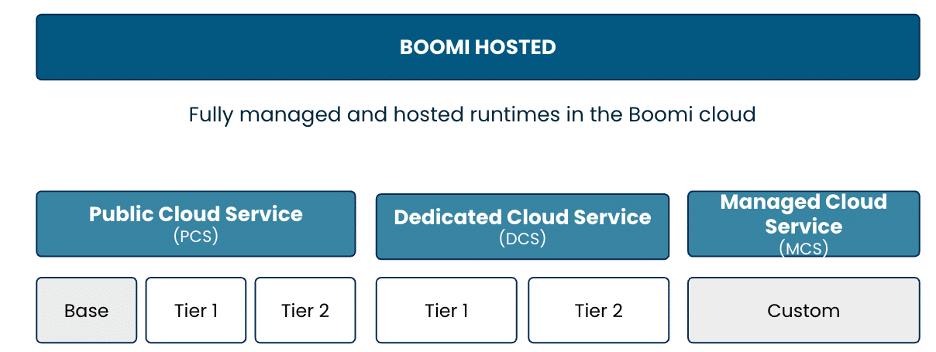Boomi Hosted Runtimes are managed environments for running integration processes, offering flexibility and scalability across three deployment models: Public Cloud Service, Dedicated Cloud Service, and Managed Cloud Service. These runtimes allow organizations to execute their integrations with minimal infrastructure management, ensuring high availability, robust security, and optimized performance.

Boomi combines cloud integration with powerful automation tools, ensuring seamless, end-to-end workflow management. Moreover, Boomi’s highly customizable environment, particularly within our Managed Cloud, offers enhanced security, full data control, and support for advanced integrations that many competitors cannot match.
Whether you need multi-tenant support or a highly customized, single-customer solution, our hosted clouds are built to integrate seamlessly with cloud and on-premises systems, making them suitable for a wide range of business needs.
Flexible Deployment Options for Every Business
Each Hosted Runtime model fits a particular set of requirements:
- Public Cloud Service provides tiered performance and scalability options, allowing you to align runtime capacity with your integration needs while maintaining predictable costs.
- Dedicated Cloud Service delivers exclusivity and control for organizations with specific compliance or performance requirements. Boomi ensures optimal execution, security, and compliance by managing infrastructure directly, reducing misconfiguration risk, and enabling centralized updates and patches.
- Managed Cloud Service offers a fully managed, hands-off experience for enterprises seeking exclusivity, simplicity, and managed operational support.
Boomi Hosted Runtimes deliver value to all key decision-makers within an organization. CIOs and VPs of Integration like the Public, Dedicated, and Managed Cloud Services for their varying levels of control, security, and customization — ideal for supporting complex integrations. Non-technical stakeholders, such as CFOs and Operations Managers, benefit from the Runtimes’ ability to execute business logic efficiently, ensuring reliable and scalable operations without requiring deep technical expertise.
Ensure High Availability and Disaster Recovery
Boomi Hosted Runtimes provide robust high availability (HA) and disaster recovery (DR) measures tailored to the chosen service options. These capabilities help organizations maintain business continuity, minimize downtime, recover quickly from disruptions, and keep mission-critical integrations running smoothly, ensuring that operations aren’t interrupted.
They also reduce the risk of unexpected outages, allowing businesses to maintain consistent performance. And they help businesses meet the uptime requirements necessary for regulatory compliance and service level agreements (SLAs).
All Boomi Hosted Runtime offerings — Public Cloud, Dedicated Cloud, and Managed Cloud Services — ensure 99.99% availability, meaning at most they experience 52 minutes of downtime per year.
Boomi Hosted Runtimes implement DR strategies to minimize data loss and ensure quick recovery in the event of system failures, outages, or cyber incidents.
- Public Cloud: DR is automatically enabled for production environments, with a Recovery Point Objective (RPO) of 4 hours and a Recovery Time Objective (RTO) of 8 hours. A RPO of 4 hours means data loss is limited to a maximum of 4 hours. An RTO of 8 hours means services can be restored within 8 hours.
- Dedicated Clouds and MCS: DR is optional and can be enabled for either test or production environments at an additional cost. These options share the same RPO and RTO (4 hours and 8 hours, respectively) as the production Public Cloud.
Data recovery regions include a dedicated DR virtual network. Fileshares are continuously replicated from the primary region to the DR region in near-real-time. However, load balancers and application clusters remain unprovisioned in the DR region until a DR event is initiated, ensuring efficient resource utilization while maintaining readiness for disaster scenarios. This architecture balances performance, reliability, and cost-effectiveness across all service options.
Which Boomi Hosted Runtime Is Right for You?
Boomi Hosted Runtimes can serve a range of organizations in terms of size and complexity. Our flexible deployment models align well with different infrastructure, compliance, and operational needs. To select which hosted runtime is right for you, we recommend evaluating your integration complexity, security requirements, and connectivity needs.
Public Cloud Service is ideal for mid-market and enterprise companies prioritizing ease of use, predictable costs, and fast deployment without needing private connectivity or infrastructure management. This model attracts SaaS companies, fast-growing tech firms, and enterprises with standardized integration needs that want fully managed cloud execution with minimal complexity. This service does not support private connectivity. Customers must use publicly accessible APIs, middleware, or hybrid integration strategies to connect to on-premises systems.
Dedicated Cloud Service suits enterprises in regulated industries (finance, healthcare, government) and large organizations that require dedicated resources while benefiting from a Boomi-managed environment. Companies that need VPN connectivity and more control over integration performance but don’t require deep customization find DCS a strong fit. This service supports private network connectivity via VPN, allowing direct access to on-premises applications and data sources.
Managed Cloud Service is structured for large enterprises with complex integration requirements, legacy dependencies, and stringent security or compliance needs. Organizations in highly regulated industries, global corporations, and companies requiring hybrid or multi-cloud orchestration benefit from custom configurations, access to a dedicated service team for operational support, and Boomi-managed infrastructure at scale. This service offers VPN, peering, and transit gateway connectivity, providing the most flexible and secure options for integrating with local systems. In addition to support for Boomi Integration, this service also supports Boomi API Management and Boomi DataHub runtimes.
For guidance on which Runtime option would best suit your business and a tailored recommendation, please contact us.
